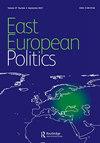Gendered parties and gendered voters in Hungary? “Plus ça change, plus c’est pariel”
IF 3.1
2区 社会学
Q1 AREA STUDIES
引用次数: 2
Abstract
ABSTRACT The article compares parties’ candidate selection strategies and voters’ electoral response to female candidates in Hungary. The analysis covers five elections (2002, 2006, 2010, 2014, 2018) that is a period which offers broad variation in partisan, institutional, and even in systemic terms amongst the static and low level of descriptive female representation. Although parties continue to deprivilege female candidates they do it in varying manners and degrees. The article will broaden the demand aspect of the demand and supply model placing parties’ candidate selection in a complex institutional context. The article also demonstrates stability in voters’ electoral gender response, namely non-discriminatory behaviour.匈牙利的性别政党和性别选民?“加上a变化,加上c 'est pariel”
本文比较了匈牙利政党的候选人选择策略和选民对女性候选人的选举反应。该分析涵盖了五次选举(2002年、2006年、2010年、2014年和2018年),这是一个在静态和低水平的描述性女性代表中,党派、机构甚至系统方面存在广泛差异的时期。尽管各政党继续剥夺女性候选人的特权,但其方式和程度各不相同。本文将扩大需求和供给模型的需求方面,将政党候选人选择置于复杂的制度背景下。本文还证明了选民的选举性别反应的稳定性,即非歧视性行为。
本文章由计算机程序翻译,如有差异,请以英文原文为准。
求助全文
约1分钟内获得全文
求助全文

 求助内容:
求助内容: 应助结果提醒方式:
应助结果提醒方式:


